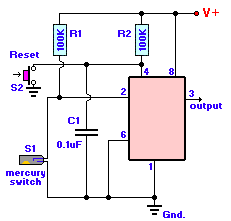| Voorbeelden |
Op deze pagina laten we een aantal voorbeelden zien die met deze timer gemaakt kunnen worden. De uitleg bij de schema's is in de Engelse taal.

|
1. Dark detector It will sound an alarm if it gets too dark all over sudden. For example, this circuit could be used to notify when a lamp (or bulb) burns out. The detector used is a regular cadmium-sulphide Light Dependent Resistor or LDR, for short, to sense the absence of light and to operate a small speaker. The LDR enables the alarm when light falls below a certain level. |

|
2. Power Alarm This circuit can be used as a audible 'Power-out Alarm'. It uses the 555 timer as an oscillator biased off by the presence of line-based DC voltage. When the line voltage fails, the bias is removed, and the tone will be heard in the speaker. R1 and C1 provide the DC bias that charges capacitor Ct to over 2/3 voltage, thereby holding the timer output low (as you learned previously). Diode D1 provides DC bias to the timer-supply pin and, optionally, charges a rechargeable 9-volt battery across D2. And when the line power fails, DC is furnished to the timer through D2. |

|
3. Tilt Switch Actually really a alarm circuit, it shows how to use a 555 timer and a small glass-encapsulated mercury switch to indicate 'tilt'. The switch is mounted in its normal 'open' position, which allows the timer output to stay low, as established by C1 on startup. When S1 is disturbed, causing its contacts to be bridged by the mercury blob, the 555 latch is set to a high output level where it will stay even if the switch is returned to its starting position. The high output can be used to enable an alarm of the visual or the audible type. Switch S2 will silent the alarm and reset the latch. C1 is a ceramic 0.1uF (=100 nano-Farad) capacitor. |

|
4. Electric Eye Alarm The Electric-Eye Alarm is actually a similar circuit like the Dark Detector. The same type of LDR is used. The pitch for the speaker can be set with the 500 kilo-ohm potentiometer. Watch for the orientation of the positive (+) of the 10uF capacitor, the '+' goes to pin 3. |

|
5. Metronome A Metronome is a device used in the music industry. It indicates the ritme by a 'toc-toc' sound which speed can be adjusted with the 250K potentiometer. Very handy if you learning to play music and need to keep the correct rhythm up. Error fixed with thanks to Grant Fair in regards to the two resistors. Grant also added a PNP power transistor to increase the volume and a led for visual as well as sound output. |

|
6. CW Practice Oscillator CW stands for Continuous Wave or Morse-Code. You can practice the morse-code with this circuit. The 100K potmeter is for the pitch and the 10K for the speaker volume. The Key is a morse code key. |

|
7. Ten-Minute Timer Can be used as a time-out warning for Ham Radio. The Federal Communications Commission (FCC) requires the ham radio operator to identify his station by giving his call-sign at least every 10 minutes. This can be a problem, especially during lengthy conversations when it is difficult to keep track of time. The 555 is used as a one-shot so that a visual warning indicator becomes active after 10-minutes. To begin the cycle, the reset switch is pressed which causes the Green led to light up. After 10 minutes, set by the 500K potentiometer R1, the Red led will light to warn the operator that he must identify. |